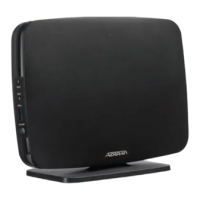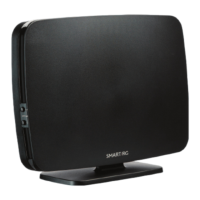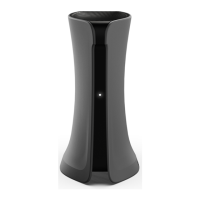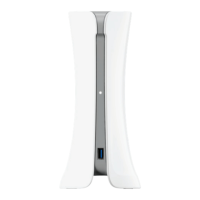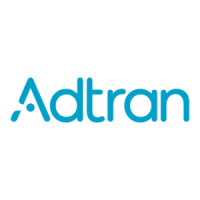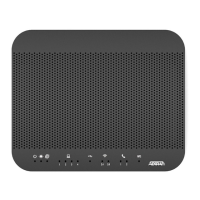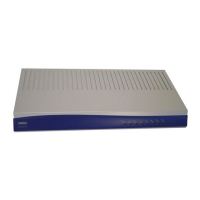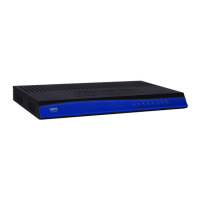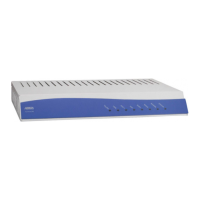Do you have a question about the ADTRAN SmartRG SR555ac and is the answer not in the manual?
Defines the manual's purpose and scope for SR555ac gateway users.
Identifies the target audience and required knowledge for this manual.
Provides contact information and resources for obtaining help with the product.
Explains the meaning of the gateway's front panel indicator lights.
Describes the various ports located on the gateway's rear and side panels.
Details the function and operation of the gateway's physical buttons.
Provides step-by-step instructions for setting up the SR555ac gateway.
Guides users on how to access and log into the gateway's web-based user interface.
Displays essential device information, software version, and WAN connection status.
Provides an overview of the WAN interface and its configuration options.
Covers IP address, IGMP snooping, DHCP server, and MAC binding for the LAN.
Shows network interface statistics for LAN, WAN Service, xTM, and xDSL.
Details how to configure ATM/PVC settings, including latency and encapsulation.
Explains how to configure PTM WAN interfaces for packet transfer.
Describes how to re-purpose LAN ports as WAN ports for ETH WAN interfaces.
Step-by-step guide to configuring a PPPoE WAN connection.
Provides instructions for configuring an IPoE WAN service.
Details on configuring a bridge WAN service, requiring a prior ATM interface setup.
Configures IP settings for the WAN interface, including DHCP or static IP.
Guides on setting up DNS servers, either by interface or static IP addresses.
Covers default gateway, static routing, policy routing, and RIP settings.
Defines rules to prevent specific outgoing traffic from the LAN to the WAN.
Defines rules to prevent specific incoming traffic from the WAN to the LAN.
Manages MAC filtering rules to control wireless client access.
Configures fundamental WiFi LAN interface features like SSID and security.
Covers network authentication modes (WPA2, PSK, etc.) and WPS setup.
Configures advanced wireless features like channel, transmission rate, and power saving.
Establishes paths between two independent networks using IP tunneling.
Secures communications using packet level encryption and authentication.
Prioritizes Internet content for better performance, managing queues and classification.
Creates traffic class rules for assigning ingress traffic to priority queues.
Configures fixed rates (Kbps) for each Ethernet port.
Runs line performance diagnostic tools for LAN, DSL, and Internet connectivity.
Tests network connectivity by pinging a server by host name or IP address.
Traces the route of a connection to a destination host.
Allows backing up current gateway settings to a file on the computer.
Provides instructions for updating the gateway's firmware.
Resets the gateway to its original factory default settings.
Displays a history of gateway events and errors, and allows system log configuration.
Enables or disables gateway services for specific interfaces and user types.
Creates and manages user accounts with customizable access privileges.
Creates a list of IP addresses allowed to access local management services.
Contains FCC compliance statements regarding interference and radiation exposure.
Covers FCC Part 68, Ringer Equivalency, IC CS-03, and Canada statements.
Defines the manual's purpose and scope for SR555ac gateway users.
Identifies the target audience and required knowledge for this manual.
Provides contact information and resources for obtaining help with the product.
Explains the meaning of the gateway's front panel indicator lights.
Describes the various ports located on the gateway's rear and side panels.
Details the function and operation of the gateway's physical buttons.
Provides step-by-step instructions for setting up the SR555ac gateway.
Guides users on how to access and log into the gateway's web-based user interface.
Displays essential device information, software version, and WAN connection status.
Provides an overview of the WAN interface and its configuration options.
Covers IP address, IGMP snooping, DHCP server, and MAC binding for the LAN.
Shows network interface statistics for LAN, WAN Service, xTM, and xDSL.
Details how to configure ATM/PVC settings, including latency and encapsulation.
Explains how to configure PTM WAN interfaces for packet transfer.
Describes how to re-purpose LAN ports as WAN ports for ETH WAN interfaces.
Step-by-step guide to configuring a PPPoE WAN connection.
Provides instructions for configuring an IPoE WAN service.
Details on configuring a bridge WAN service, requiring a prior ATM interface setup.
Configures IP settings for the WAN interface, including DHCP or static IP.
Guides on setting up DNS servers, either by interface or static IP addresses.
Covers default gateway, static routing, policy routing, and RIP settings.
Defines rules to prevent specific outgoing traffic from the LAN to the WAN.
Defines rules to prevent specific incoming traffic from the WAN to the LAN.
Manages MAC filtering rules to control wireless client access.
Configures fundamental WiFi LAN interface features like SSID and security.
Covers network authentication modes (WPA2, PSK, etc.) and WPS setup.
Configures advanced wireless features like channel, transmission rate, and power saving.
Establishes paths between two independent networks using IP tunneling.
Secures communications using packet level encryption and authentication.
Prioritizes Internet content for better performance, managing queues and classification.
Creates traffic class rules for assigning ingress traffic to priority queues.
Configures fixed rates (Kbps) for each Ethernet port.
Runs line performance diagnostic tools for LAN, DSL, and Internet connectivity.
Tests network connectivity by pinging a server by host name or IP address.
Traces the route of a connection to a destination host.
Allows backing up current gateway settings to a file on the computer.
Provides instructions for updating the gateway's firmware.
Resets the gateway to its original factory default settings.
Displays a history of gateway events and errors, and allows system log configuration.
Enables or disables gateway services for specific interfaces and user types.
Creates and manages user accounts with customizable access privileges.
Creates a list of IP addresses allowed to access local management services.
Contains FCC compliance statements regarding interference and radiation exposure.
Covers FCC Part 68, Ringer Equivalency, IC CS-03, and Canada statements.
| Device Type | Gateway |
|---|---|
| Wireless Frequency Bands | 2.4 GHz, 5 GHz |
| USB Ports | 1 x USB 2.0 |
| Power Supply | 12V DC, 1.5A |
| Wi-Fi Standards | 802.11ac, 802.11n, 802.11g, 802.11b |
| WAN Interface | 1 x Gigabit Ethernet |
| LAN Interface | 4 x Gigabit Ethernet |
| Wireless Speed | Up to 1300 Mbps |
| Maximum Wireless Speed | 1750 Mbps |
| Dimensions | 8.5 x 6.5 x 1.5 inches |
| Weight | 1.5 lbs |
